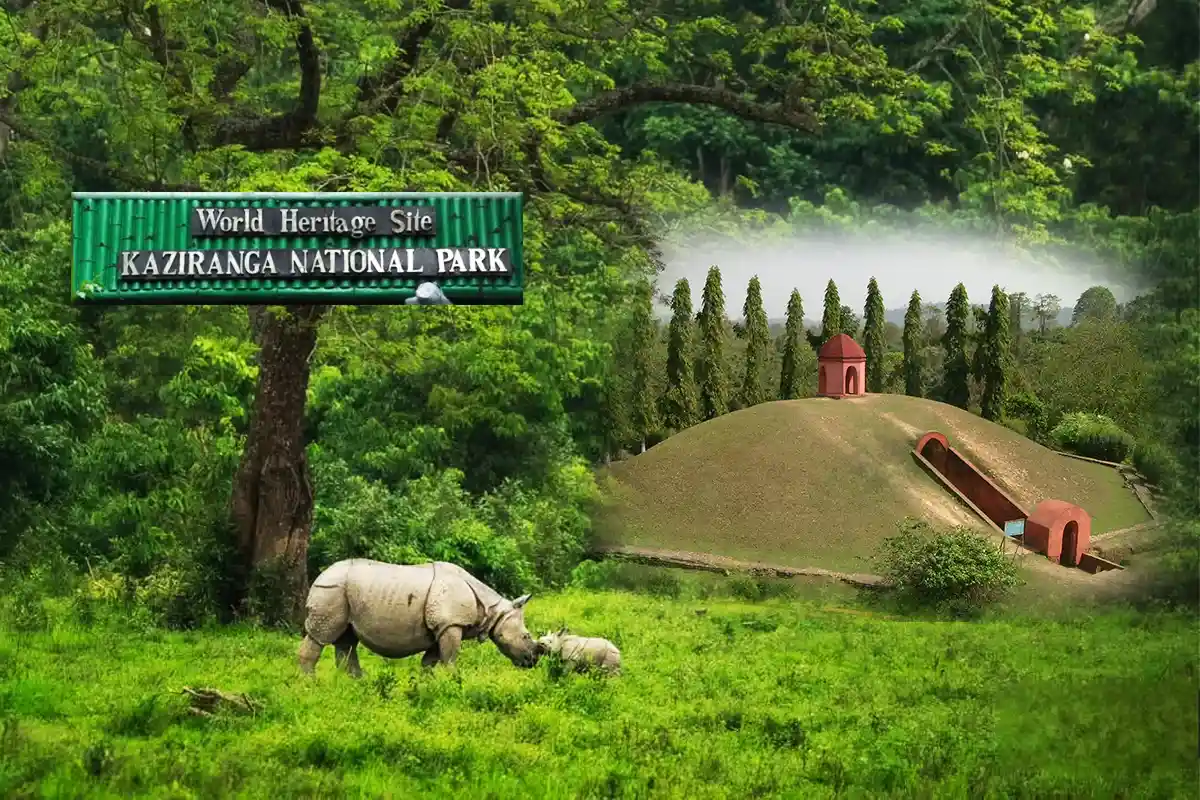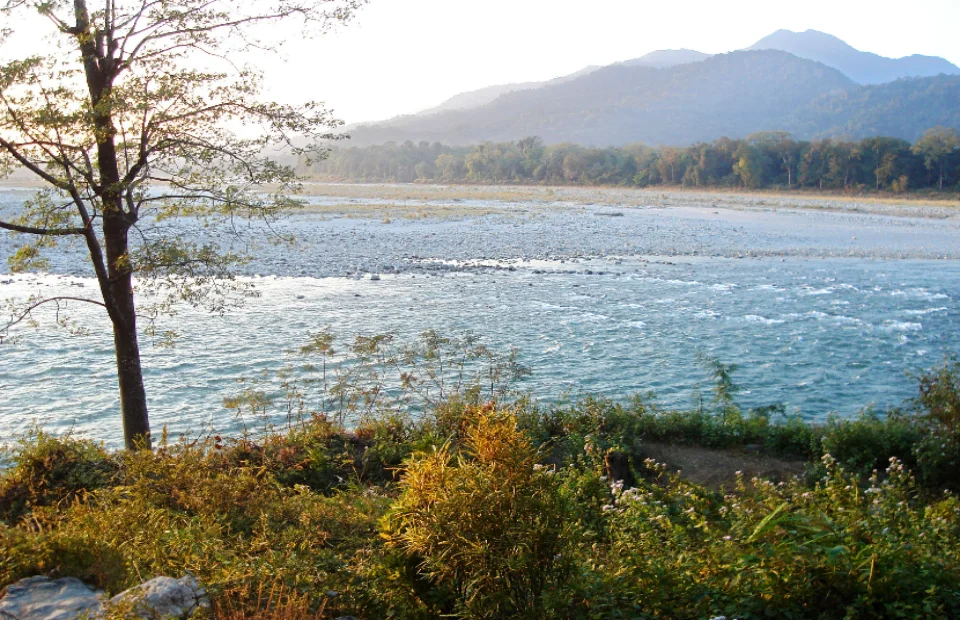Let’s dwell on the various aspects of heritage tourism in Assam and its significance through a journey exploring the important UNESCO World Heritage Sites.
Diversity Assam
Updated on :
Share this post
From the towering Moidams of Charaideo to the lush grasslands of Kaziranga and the serene foothills of Manas, Assam’s UNESCO sites are not just places—they are stories etched into the land, waiting to inspire every visitor.
Nestled between the towering Greater Himalayas and the lush Malaya Peninsula, Assam is a land of unparalleled biodiversity, vibrant culture, and rich heritage. This unique geographical position makes Assam a melting pot of flora, fauna, and human traditions, thereby making it a significant spot for exploring heritage tourism in Assam.

From its breathtaking landscapes to its multi-religious communities coexisting harmoniously, Assam exemplifies the spirit of unity in diversity. The recognition of Assam’s treasures as UNESCO World Heritage Sites is not merely a badge of honor—it is a testament to the region’s historical, cultural, and ecological importance. Among these treasures, the most celebrated include Charaideo Maidam, Kaziranga National Park, and Manas National Park, each holding immense significance contributing to heritage tourism in Assam.
The recent addition of Charaideo Maidam as a UNESCO World Heritage Site has once again placed Assam in the global spotlight. But why do these recognitions matter? Let’s first explore these iconic sites before delving into their broader significance.
3 UNESCO World Heritage Sites to Explore Heritage Tourism in Assam
1. Charaideo Maidam

The first site from Northeast India to receive UNESCO recognition under the Cultural Category, Charaideo Maidam, is often likened to the Pyramids of Egypt or the royal burial mounds of ancient China. These majestic mound-burials, known as Moidams, stand as a testament to the architectural prowess, spiritual beliefs, and rich heritage of the Tai-Ahom dynasty, which ruled Assam for over six centuries. Unfortunately, years of neglect and urbanization had put this legacy at risk, making UNESCO’s recognition a critical step towards its preservation.
2. Kaziranga National Park

Recognized as a Natural Heritage Site in 1985, Kaziranga is a jewel of Assam, harboring over 70% of the world’s one-horned rhinoceroses. It is also home to majestic tigers, swamp deer, wild buffaloes, and a plethora of bird species. Spanning across floodplains, wetlands, and grasslands, this park is not only a wildlife haven but also a symbol of Assam’s commitment to conservation. And thereby making it a natural paradise to explore heritage tourism in Assam.
3. Manas National Park

Another Natural Heritage Site inscribed in 1985, Manas National Park lies at the foothills of the Himalayas and is contiguous with Bhutan’s Royal Manas National Park. A rare gem, it is the only site in India designated as a World Heritage Site, a Tiger Reserve, an Elephant Reserve, a Biosphere Reserve, and an Important Bird Area—all at once. The park derives its name from the Manas River, named after the serpent goddess Manasa, blending natural and mythological significance.
Also read: Top 11 Most Visited Tourist Places In Assam
Delving back into the question as to why we need these UNESCO recognitions and why this matter so much to promote Heritage tourism in Assam!
The significance of UNESCO recognition extends beyond mere prestige. It is a vital step toward preserving age-old cultures, natural habitats, and human ingenuity. In a rapidly globalizing world where cultural values and biodiversity are often sidelined by urbanization and capitalism, these recognitions act as shields against erosion. For instance, Charaideo Maidam’s recognition came at a time when its structures were deteriorating, signaling an urgent need for protection.
Benefits of UNESCO Recognitions
1. Preservation of Heritage
Recognition by UNESCO ensures that efforts are made to protect and restore sites that hold historical, cultural, or ecological significance. For Charaideo Maidam, this means safeguarding the legacy of the Tai-Ahom dynasty for future generations.
2. Boost to Heritage Tourism in Assam and Revenue Generation
Tourism, recently declared an industry by the Assam government, stands to benefit immensely. World Heritage status attracts global tourists, offering a chance to showcase Assam’s beauty and heritage. This, in turn, generates revenue and bolsters the state economy adding into a significant growth in Heritage tourism in Assam.
3. Employment Opportunities
The growth of tourism directly and indirectly creates jobs for local communities. From guides and hoteliers to craft sellers, the opportunities are diverse. It also promotes self-employment by encouraging locals to capitalize on the influx of visitors. For many young people in general, historians, archaeologists, and entrepreneurs, Heritage tourism in Assam may offer a variety of opportunities.
4. Attracting Investment
Recognition brings in both public and private investments. For instance, the TATA Group has announced plans to develop a five-star hotel near Kaziranga. Such developments not only attract foreign tourists but also increase foreign exchange earnings for the country.
5. Infrastructure Development
The Heritage tourism in Assam boom necessitates improved infrastructure, benefiting both locals and visitors. Initiatives like the introduction of Vande Bharat train services and special tourist buses are excellent examples of how heritage sites catalyze development.
As Henri Matisse beautifully said,
“There are always flowers for those who want to see them.”
Assam’s World Heritage Sites are the blooming flowers of its heritage and natural wealth, offering beauty, inspiration, and opportunity to those who cherish them. They are the representatives of our land, adding to the growth and sustentation of Heritage tourism in Assam. But these recognitions also come with responsibilities. As proud custodians of this rich legacy, it is our duty to preserve the uniqueness and diversity of Assam’s culture and nature.
Endnotes
Let us actively participate in conservation efforts, be mindful of our heritage, and educate future generations about the importance of these sites. With collective effort, Assam’s treasures can continue to shine on the global stage, reminding the world of the region’s unparalleled beauty and resilience. Let us uphold the spirit of unity in diversity, ensuring that these masterpieces remain sources of pride and prosperity for years to come.
